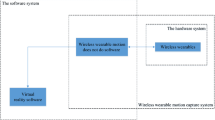Abstract
In recent years, the increase in health awareness has made fitness activities more and more popular in families. The lack of professional guidance and real-time feedback during home fitness training is often a limiting factor. In order to solve this problem, a home fitness assistance system based on Android mobile network and optical sensing system is proposed in this study. The purpose of the system is to provide personalized fitness guidance and real-time feedback to help users effectively conduct fitness training in a home environment. In order to achieve this goal, this paper uses the advantages of Android mobile network to realize real-time interaction and communication between users and the system. A fitness detection system based on light sensing technology is designed, which can accurately monitor the user’s posture and movement, and provide corresponding feedback. Through the analysis of the experimental results, the home fitness assistance system has high accuracy and efficiency in providing personalized fitness guidance and real-time feedback. Users can choose the right training plan according to their needs and abilities, and get professional guidance and real-time feedback in the training process, so as to achieve better training results.




Similar content being viewed by others
Data availability
The data will be available upon request.
References
Chu, S.W., Song, Y., Zouo, J.J., Cai, W.: Human pose estimation using deep convolutional densenet hourglass network with intermediate points voting. In 2019 IEEE International Conference on Image Processing (ICIP) (pp. 594–598). IEEE. (2019), September
Fan, Y., **, H., Ge, Y., Wang, N.: Wearable motion attitude detection and data analysis based on internet of things. IEEE Access. 8, 1327–1338 (2019)
Geng, P., Shi, S., Guo, H.: A preliminary study on attitude recognition from speaker’s orofacial motions using random forest classifier. In Thirteenth International Conference on Digital Image Processing (ICDIP 2021) (Vol. 11878, pp. 29–34). SPIE. (2021), June
Iqbal, M., Naeem, M., Anpalagan, A., Ahmed, A., Azam, M.: Wireless sensor network optimization: Multi-objective paradigm. Sensors. 15(7), 17572–17620 (2015)
Liem, J., Perin, C., Wood, J.: Structure and empathy in visual data storytelling: Evaluating their influence on attitude. In Computer Graphics Forum (Vol. 39, No. 3, pp. 277–289). (2020), June
Peng, D., Yi, Z., Lv, J.C., **ang, Y.: A stable MCA learning algorithm. Comput. Math Appl. 56(4), 847–860 (2008)
Santos, O.C.: Artificial intelligence in psychomotor learning: Modeling human motion from inertial sensor data. Int. J. Artif. Intell. Tools. 28(04), 1940006 (2019)
Shakkottai, S., Srikant, R.: Network optimization and control. Found. Trends® Netw. 2(3), 271–379 (2008)
Wierinck, E., Puttemans, V., Swinnen, S., van Steenberghe, D.: Effect of augmented visual feedback from a virtual reality simulation system on manual dexterity training. Eur. J. Dent. Educ. 9(1), 10–16 (2005)
Wierinck, E.R., Puttemans, V., Swinnen, S.P., van Steenberghe, D.: Expert performance on a virtual reality simulation system. J. Dent. Educ. 71(6), 759–766 (2007)
Wierniuk, A., Wlodarek, D.: Estimation of energy and nutritional intake of young men practicing aerobic sports. Roczniki Państwowego Zakładu Higieny, 64(2). (2013)
Yanru, Z., Guohui, T., **n, G., Fengyu, Z.: The design and application of human attitude detector based on inertial measurement unit. In 2011 Chinese Control and Decision Conference (CCDC) (pp. 2772–2777). IEEE. (2011), May
Zhang, F., Wu, T.Y., Pan, J.S., Ding, G., Li, Z.: Human motion recognition based on SVM in VR art media interaction environment. Human-centric Comput. Inform. Sci. 9, 1–15 (2019)
Zhu, C., Shao, R., Zhang, X., Gao, S., Li, B.: Application of virtual reality based on computer vision in sports posture correction. Wirel. Commun. Mob. Comput. 2022, 1–15 (2022)
Funding
This paper was supported by (1) The programme of Philosophy and Social Science Research of Jiangsu Province University: Research on Multiple linkage mechanism of youth sports public Service Promotion subject from the perspective of collaborative governance, No. 2023SJYB1257; (2) The programme of Philosophy and Social Science Foundation of Jiang Su Province: Research on Mechanism Innovation and Path of The Integration Between Sports and Hospital Under the Background of “Healthy Jiang Su 2030”, No. 20TYB010; (3) The programme of teaching and research of Jiangsu University of Technology, Research on the competence of college physical education teachers under the background of wisdom education, No.11611612303.
Author information
Authors and Affiliations
Contributions
Q.S. has done the first version, J.L. and L.L. has done the simulations. All authors have contributed to the paper’s analysis, discussion, writing, and revision.
Corresponding author
Ethics declarations
Ethical approval
Not applicable.
Competing interests
The authors declare no competing interests.
Additional information
Publisher’s Note
Springer Nature remains neutral with regard to jurisdictional claims in published maps and institutional affiliations.
Rights and permissions
Springer Nature or its licensor (e.g. a society or other partner) holds exclusive rights to this article under a publishing agreement with the author(s) or other rightsholder(s); author self-archiving of the accepted manuscript version of this article is solely governed by the terms of such publishing agreement and applicable law.
About this article
Cite this article
Si, Q., Liu, J. & Liu, L. Design of home fitness assistant system based on android mobile network and optical sensing system. Opt Quant Electron 56, 694 (2024). https://doi.org/10.1007/s11082-024-06550-0
Received:
Accepted:
Published:
DOI: https://doi.org/10.1007/s11082-024-06550-0




